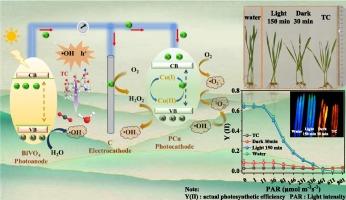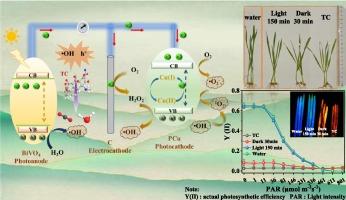在宽 pH 值范围内快速降解新兴污染物的可持续双阴极光电-类芬顿系统
IF 13.3
1区 工程技术
Q1 ENGINEERING, CHEMICAL
引用次数: 0
摘要
原位 Fenton 类工艺在处理新出现的有机污染物方面前景广阔,而且节能高效。然而,H2O2 的产生和活化是其实际应用所面临的挑战。在此,我们成功制备了一种光电-类芬顿(PEF)系统,分别以 BiVO4 薄膜、石墨(C)和 PhC2Cu 作为光阳极、阴极和光阴极。该三元系统在 0.5 V 的低电位下用于可见光降解四环素(TC),在石墨阴极产生 H2O2,然后由 PhC2Cu 光阴极的 Cu(Ⅰ)激活产生 -OH。光生电子加速了 Cu(Ⅰ)/Cu(Ⅱ)循环,从而实现了可持续的 PEF 反应。光照 150 分钟后,BiVO4|C|PCu 体系中 97% 的 TC 被降解,优于 BiVO4|C 和 BiVO4|PCu 体系。该 PEF 系统出色的稳定性和可重复使用性已通过 10 次循环得到证明。此外,TC 分子的易损原子位点是通过福井函数确定的。细菌抑菌区试验和小麦种子培养实验均证明,所构建的 PEF 系统在抑制 TC 生态毒性方面表现出色。例如,Fv/Fm 荧光图像图表明,所构建的 PEF 系统不仅能降解有机污染物,还能降低其毒性。最后,根据淬灭实验、PL 光谱和 ESR 技术的结果,提出了 H2O2 的原位生成和活化机制。总之,这项研究为通过构建基于双阴极的 PEF 系统来修复环境污染提供了一条前景广阔的途径。本文章由计算机程序翻译,如有差异,请以英文原文为准。


Sustainable dual-cathode photoelectro-Fenton-like system at a wide pH range for rapid degradation of emerging pollutants
In-situ Fenton like process was highly promising and energy-efficient for treating emerging organic contaminants. However, the challenge in the production and activation of H2O2 faces its practical application. Herein, a photoelectro-Fenton-like (PEF) system was successfully fabricated with BiVO4 thin-film, graphite (C) and PhC2Cu as photoanode, cathode and photocathode, respectively. The ternary system was applied for visible-light degradation of Tetracycline (TC) at a low potential of 0.5 V. H2O2 was generated at the graphite cathode and then activated to produce •OH by Cu(I) from PhC2Cu photocathode. The photo-generated electrons accelerated the Cu(I)/Cu(II) cycle to achieve sustainable PEF reactions. After 150 min of illumination, 97 % TC was degraded in BiVO4|C|PCu system, superior to BiVO4|C and BiVO4|PCu systems. The outstanding stability and reusability of this PEF system was proved by 10 cycles. Moreover, the vulnerable atomic sites of TC molecule were predicated by the Fukui function. Both inhibition zone tests of bacteria and wheat seeds cultivation experiments proved that the constructed PEF system displayed outstanding performance in hampering TC eco-toxicity. For example, the Fv/Fm fluorescence image map demonstrated that the constructed PEF system not only degraded organic pollutants but also lowered their toxicity. Finally, the mechanism of in-situ generation and activation of H2O2 was proposed based on the results of quenching experiments, PL spectra and ESR technique. Overall, this study provides a promising pathway to remediate environmental pollution through constructing a PEF system based on dual cathodes.
求助全文
通过发布文献求助,成功后即可免费获取论文全文。
去求助
来源期刊

Chemical Engineering Journal
工程技术-工程:化工
CiteScore
21.70
自引率
9.30%
发文量
6781
审稿时长
2.4 months
期刊介绍:
The Chemical Engineering Journal is an international research journal that invites contributions of original and novel fundamental research. It aims to provide an international platform for presenting original fundamental research, interpretative reviews, and discussions on new developments in chemical engineering. The journal welcomes papers that describe novel theory and its practical application, as well as those that demonstrate the transfer of techniques from other disciplines. It also welcomes reports on carefully conducted experimental work that is soundly interpreted. The main focus of the journal is on original and rigorous research results that have broad significance. The Catalysis section within the Chemical Engineering Journal focuses specifically on Experimental and Theoretical studies in the fields of heterogeneous catalysis, molecular catalysis, and biocatalysis. These studies have industrial impact on various sectors such as chemicals, energy, materials, foods, healthcare, and environmental protection.
 求助内容:
求助内容: 应助结果提醒方式:
应助结果提醒方式:


